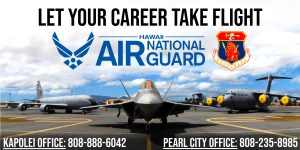Life saver takes ‘fast track’ in career progression
Posted on Dec 1, 2018 in Main154th Wing Public Affairs
Story by Senior Airman John Linzmeier
Tuesday, November 27, 2018
#####
Life-threatening scenarios seem to occur at the most random of times and places; and when they do, it’s usually not a pretty scene.
While most people go about their daily lives hoping to steer clear and far away from incidents, there are others who strive to be in positions where they can offer help at the forefront of emergency.
For Senior Airman Casey Whitworth, it’s hard to imagine a lifestyle that doesn’t involve helping others. As a fulltime beach lifeguard at Marine Corps Base Hawaii and medical first-responder in the Hawaii Air National Guard, Whitworth’s lifesaving skills can be called upon at any time.
“I always knew I wanted to be in sort of emergency response, like my uncle who’s a paramedic. His job seemed like a lot of fun, so I ended up following in his footsteps, and now we’re working together in the same unit,” said Whitworth. “It really turned out to be a fast-track way to get some quality career experience.”
By the age of 19, Whitworth became a certified emergency medical technician in the 154th Medical Group’s All-Hazard Triage team, assigned to Detachment 1. The training equipped him with skills to aid victims affected by chemical, biological, radiological and nuclear environments amongst other hazards. Two years later, he was hand-picked to complete EMT bridge program at Kapiolani Community College. The accelerated course served as a scholarship and hands-on-internship, making him an employable and licensed technician in the state of Hawaii.
Within the last six months, he engaged in a variety of crisis events, consisting of hurricanes, the Big Island volcanic outbreak and, most recently, a downed helicopter rescue that occurred on a sandbar in Kaneohe Bay.
As Whitworth was wrapping up his lifeguard shift on October 22, he was informed about a commercial-helicopter crash over the radio. He and two other lifeguards boarded a jet ski and made their way to the crash site, where they found several bystanders attending to the fallen aircraft. Both parties worked together to ensure a quick recovery.
“It was a kind of surreal experience,” said Whitworth, “When I was triaging the victims, it was hard to believe that they could make it through a helicopter crash in their condition. They didn’t appear to have any outstanding injuries, so it was pretty miraculous.”
Tide levels continued to drop throughout the extraction, making it more challenging to bring passengers back to shore. Whitlock and the rescue team ended up dragging the watercraft and a victim through an estimated 150 to 200 meters of shallow water, said to be only a few inches deep at some parts. With the help of a few good Samaritans, all victims made it to shore safety, and two passengers were healthy enough to fly back to their home in the mainland U.S. the next day.
While recovery operations tend to be grueling and, in less fortunate cases, full of heartache, emergency response members seem to fully-embrace the occasional hardships and relentless training that comes with the job.
According to Senior Master Sgt. Jared Mina, Detachment 1 superintendent, Airmen like Whitworth barely need to think about what to do in rapid-response scenarios because their reactions happen instinctively, due to the extensive amount of training and variety of expertise in his unit.
Most of the Airmen assigned to Detachment 1’s Chemical, Biological, Radiological, Nuclear, High Yield Explosive Enhanced Response Force Package are medical professionals in the civilian sector. In addition to their military title, many of them are full time doctors, nurses, physician assistants, firefighters, paramedics, college instructors and lifeguards.
“Being surrounded by a community like this makes all the difference,” said Mina, “because the drive and mentality rubs off and elevates our newer Airmen. Especially for guys like Whitworth, who joined straight-out-of high school. I’ve seen him go through a tremendous amount of growth because he’s surrounded by people who have been doing this kind of work for years.”
Unlike most agencies in the 154th Wing, which typically have a few days to mobilize and deploy, CERFP Airmen need to be ready gear up and head out the door within hours. Mina said this short-dispatch window is hardly an issue in Detachment 1, since Airmen often volunteer before being asked to deploy. This was especially the case during this year’s volcano outbreak on the Big Island when medical teams were embedded into Joint Task Force 5-0 to provide a medical presence.
“Since it’s my passion, I see every call as an opportunity,” said Whitworth. “In this case, I got to see volcanic eruptions, which was an incredible, one-time experience. I think people don’t sign up because they want to stay home and do nothing; it’s because they want to go through something which they couldn’t do otherwise.”
With an extensive network of medical professionals in the CERFP community, which he calls ‘a second family,’ Whitworth has plenty of directions to take his life-saving career within the Hawaiian Islands. But for now, his aspirations are to further his military career and become an active duty pararescueman, which is no small feat.
This special-operations position entails more than 500 days of intensive training, prepping the Airman to carry out rescue missions in hostile or otherwise unreachable areas. Approximately 70 to 80 percent of candidates who set off to take the pararescue indoctrination course are unable to complete the training due to mental or physical limitations.
Regardless of the course’s high washout rate, Whitworth’s leadership have shown nothing but support and confidence in his long-term goals.
“Honestly, I’m sure that anyone here would be very surprised if he doesn’t make the cut,” said Mina. “After watching his performance and seeing his ability to execute over the years, I see no reason to question his ability to succeed in whatever he puts his mind to.”
